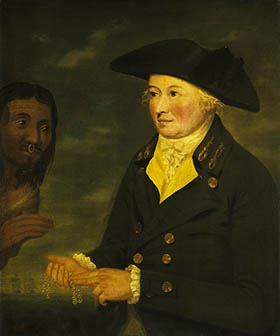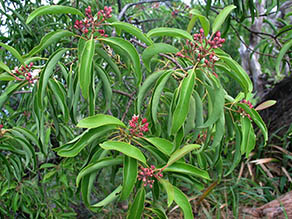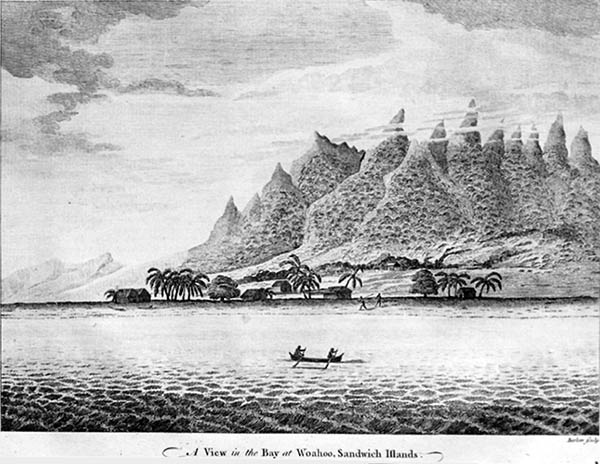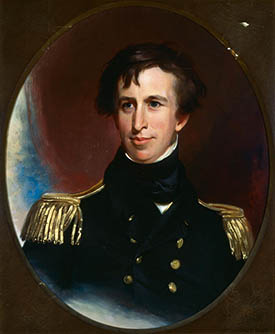 |
 |
 |
 |
||||||
|
|
|
|
|
|
|
|
|
|
 |
 |
 |
|
|
 |
 |
Despite the enormous contact with explorers on the Honolulu side of the island, none of the early Western explorers seem to have come over to the Ko‘olaupoko side. “Vancouver sailed by,” Lilikala says. “I think he moored slightly off of Kāne‘ohe Bay. He does have a description of Kāne‘ohe. He said that everything from the mountain down to the sea was cultivated. If you go on Ava Konohiki and you look at the 1800s maps, you can see, especially in Kāne‘ohe, how many wetland taro gardens there were. From essentially where the Likelike tunnel is, the Wilson tunnel, all the way down to the ocean was a wetland taro farm. You can still see the map of it.” 
Nathaniel Portlock, a British seaman who had served on Captain Cook’s third voyage, came to the islands in 1786 to develop the fur trade. He wrote of Kāne‘ohe Bay, “The bay all round has a very beautiful appearance, the low land and valleys being in a high state of cultivation, and crowded with plantations of taro, sweet potatoes, sugar cane, etc., interspersed with a great number of coconut trees, which renders the prospect truly delightful.” And Commodore Charles Wilkes of the United States Exploring Expedition came to Kāne‘ohe in 1840. Here is what he wrote (Wilkes Vol. IV: 90-91):
But the decrease in population Wilkes referred to was real. New diseases brought by the explorers traveled quickly, from Captain Cook’s very first stop on Kaua‘i and Ni‘ihau. Their impact was felt throughout the islands. “A lot of workers on the fishponds and on the taro fields,” Mahealani adds, “a lot of them died during the epidemics of the 1800s when Westerners came and brought diseases. So, thousands of people died from those diseases, and those were the workers that took care of the farms and the fishponds.” “Here in Hawai‘i there were so many things to be taken advantage of,” Rick explains. “And our natural resources were the first thing that was exploited. We got the cutting down of hapu‘u [tree fern] for the soft fibers to make quilts and pillows. And then the whole sandalwood trade. "The history of the sandalwood trade in Hawai‘i was just devastating. It completely destroyed the social dynamic of Hawaiians, and the family structure, and that sense of ‘ohana in Hawai‘i. It happened at a time when the monarchy is now feeding off of this, ‘Okay, we’re getting super rich.’ The whole reason why our monarchy was treated like royalty and became royalty was because of the selling of sandalwood.’ And the sandalwood industry in Hawai‘i which took place in 1820s. 
“From a local perspective, what it did was, Hawaiians were treated like slaves. The men were forced out of their families. So the men, as far as their role in the family and their role within the community especially, all of the men were driven out to go and collect sandalwood. “Now, there’s nobody tending the lo‘i, there’s nobody out fishing for fish. The families were left to struggle. Everything was unkept, and there’s even documentation of the point getting so bad that the women and children of these men would go up into the forest and pull out the baby sandalwoods to kill the industry. Crazy. And then by the time the men came back, it was too late already. There was too much social change going on with the influx of everybody else coming into Hawai‘i. “But that was the turning point to me in Hawaiian history, the sandalwood trade. It took away that strong, solid foundation of the family at a time when there was so much change going on. It broke up the family. Now everybody is scattered everywhere, and now there’s all of these new accommodations and new lifestyles coming in, at a point when Hawaiians didn’t really have a lifestyle because their families were broken up because all the men were up in the mountains. “So just in that short period of time, it completely changed Hawai‘i.” |
 |
 |
|
 |
||
 |
|
 |
||

|
 |
||||
|
||||
Copyright 2019 Pacific Worlds & Associates • Usage Policy • Webmaster |
||||


